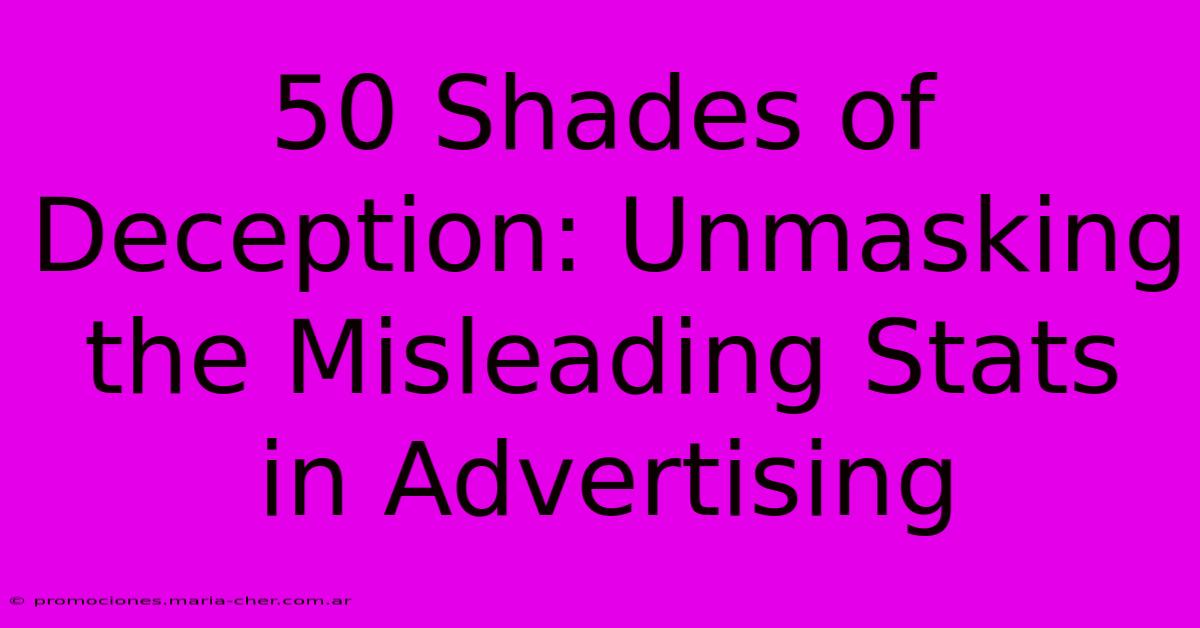50 Shades Of Deception: Unmasking The Misleading Stats In Advertising

Table of Contents
50 Shades of Deception: Unmasking the Misleading Stats in Advertising
We're bombarded with statistics daily. Advertising uses numbers to convince us – to buy products, choose services, and adopt beliefs. But how often do we critically examine these claims? This article dives into the deceptive tactics advertisers employ, revealing the hidden truths behind those seemingly impressive figures. We'll explore common misleading statistical practices and equip you with the tools to become a more discerning consumer.
The Art of the Misleading Statistic: Common Tricks
Advertisers are masters of manipulation, often using sophisticated (or surprisingly simple) techniques to skew data in their favor. Here are some of the most common:
1. Cherry-Picking Data: The "Best" Numbers Only
Imagine a weight-loss product boasting a "90% success rate." Sounds amazing, right? But what if that 90% is based only on the small percentage of participants who followed the program perfectly and reported significant weight loss? This is cherry-picking: selecting data that supports a claim while ignoring contradictory evidence. Look for studies with comprehensive data sets and clear methodologies.
2. Vague and Unquantifiable Claims: The "Up to" Gambit
Phrases like "up to 50% off" or "improves performance by up to 20%" are intentionally vague. The advertised discount or improvement might only apply to a tiny fraction of cases, leaving the majority disappointed. Demand specific details and concrete examples to avoid being misled.
3. Misrepresenting Correlations: Assuming Causation
Just because two things happen together doesn't mean one causes the other. For example, an advertisement might claim that using a particular skincare product led to clearer skin in a study. However, other factors, such as diet or lifestyle, could be the true cause. Beware of claims implying direct causation without robust evidence.
4. Using Small Sample Sizes: The Law of Small Numbers
Results based on tiny sample sizes are inherently unreliable. A study with only 20 participants may show a significant effect simply due to chance. Look for studies with large sample sizes that reduce the likelihood of random variations influencing the outcome.
5. Confusing Percentages and Absolute Numbers: Playing with Scale
A product might claim a 10% increase in sales, which sounds impressive. However, if the initial sales were very low, this 10% increase represents a minor change in absolute terms. Always consider the context and the actual numbers involved.
6. Omitting Crucial Information: The Silent Treatment
Often, advertisers will highlight positive results while conveniently leaving out negative findings or significant limitations of their study. Be wary of incomplete or overly simplistic presentations of data. Look for transparency and full disclosure of methodology and results.
How to Spot and Avoid Misleading Statistics in Advertising
Becoming a more critical consumer requires developing a healthy skepticism and asking the right questions. Here's how:
- Look for the source: Who conducted the study? Is it an independent organization, or is it funded by the company promoting the product?
- Examine the methodology: How was the data collected and analyzed? Was the sample size appropriate? Are there any biases?
- Ask for specifics: Don't settle for vague claims. Demand concrete data and examples.
- Consider the context: Do the statistics make sense given the product or service being advertised?
- Do your own research: Don't rely solely on the information provided by the advertiser. Look for independent reviews and analyses.
The Power of Critical Thinking: Beyond the Numbers
By understanding the common ways advertisers manipulate statistics, you'll be better equipped to make informed decisions. Don't let numbers deceive you; develop your critical thinking skills and empower yourself to navigate the world of advertising with clarity and confidence. The ability to critically evaluate information is a valuable asset in today's information-saturated environment. Remember: a little skepticism goes a long way.

Thank you for visiting our website wich cover about 50 Shades Of Deception: Unmasking The Misleading Stats In Advertising. We hope the information provided has been useful to you. Feel free to contact us if you have any questions or need further assistance. See you next time and dont miss to bookmark.
Featured Posts
-
Discover The Ancient Power Of Celtic Ogham Unveil The Secret Messages Hidden In Symbols
Feb 08, 2025
-
Prepare For Happiness Overload Elios Happy Meal Extravaganza
Feb 08, 2025
-
Unlocking The Power The Mercedes Amg F1 Logo A Symbol Of Speed And Innovation
Feb 08, 2025
-
Dont Miss Out One Illinois Souths Exclusive Formula For Achieving Unstoppable Momentum
Feb 08, 2025
-
The Ultimate Guide To Mastering Nef To Jpg Conversions
Feb 08, 2025
